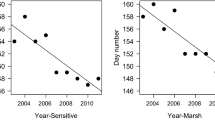Abstract
Biological differences among 3 morphologically identical populations ofAphytis which would key down toA. maculicornis (Masi) are presented through studies conducted on their reproductive isolation, host preferences and adult suvivorships at different temperatures. These results supplement results on experimental hydridization and provide ample evidence that from a practical biological control stand-point as well as from basic biosystematics, these 3 populations are valid species, distinct from each other. The significance of such sibling species in relation to biological control is discussed.
Résumé
Cette étude concerne trois groupes de populations allopatriques deAphytis maculicornis indistinguables du point de vue morphologique — «Perse», «Pakistan» et «Californie». Des tests d'accouplement à choix multiples ont essentiellement indiqué un isolement complet de ces groupes pour la reproduction. Des expériences qui comprenaient six différentes espèces de cochenilles ont démontré qu'il existait des différences significatives de préférence d'hôte parmi les trois populations. Des tests déterminant la longévité des adultes ont également indiqué des différences significatives d'une population à l'autre, surtout à une température de 27°C. On en conclut que ces populations représentent trois espèces sœurs bien distinctes. Ces résultats soulignent l'importance de telles espèces sœurs dans le domaine de la lutte biologique.
Similar content being viewed by others
References
DeBach, P. — 1969. Uniparental, sibling and semispecies in relation to taxonomy and biological control. —Israel J. Entomol. 4, 11–28.
Dobzhansky, Th. &Mayr E. — 1944. Experiments on sexual isolation inDrosophila. I. Geographic strains ofD. willistoni. —Proc. Nat. Acad. Sci., 30, 238–44.
Dobzhansky, Th. &Streisinger, G. — 1944. Experiments on sexual isolation inDrosophila. II. Geographic strains ofD. prosaltans. —Proc. Nat. Acad. Sci., 30, 340–45.
Dobzhansky, Th. &Spassly, B. — 1959.Drosophila paulistorum, a cluster of species in statu nascendi. —Proc. Nat. Acad. Sci., 45, 419–428.
Doutt, R.L. — 1954. An evaluation of some natural enemies of the olive scale. —J. Econ. Entomol., 47, 39–43.
Hafez, M. &Doutt, R.L. — 1954. Biological evidence of sibling species inAphytis maculicornis (Masi) [Hymenopt.: Aphelinidae]. —Can. Entomol., 86, 90–96.
Hall, J.C., Schlinger, E.I. &Van den Bosch, R. — 1962. Evidence for the separation of the “sibling species”Tryoxis utilis andT. pallidus [Hymenopt.: Braconidae, Aphidiinae]. —Ann. Entomol. Soc. Am., 55, 566–568.
Huffaker, C.B., Kennett, C.E. &Finney, G.L. — 1962. Biological control of olive scale,Parlatoria oleae (Colvée), in California by importedAphytis maculicornis (Masi) [Hymenopt.: Aphelinidae]. —Hilgardia, 32, 451–636.
Khasimuddin, S., &DeBach, P. — 1975. Mating behavior and evidence of a male sex pheromone in species of the genusAphytis Howard [Hymenopt.: Aphelinidae]. —Ann. Entomol. Soc. Am., 68, 893–896.
— — 1976. Hydridization tests a method for establishing biosystematic statuses of cryptic species parasitic Hymenoptera. —Ann. Entomol. Soc. Am., 69, 15–20.
Levene, J. — 1949. A new measure of sexual isolation. —Evolution, 3, 315–21.
Stalker, H.D. — 1942. Sexual isolation studies in the species complex ofD. virilis. —Genetics, 27 238–57.
Author information
Authors and Affiliations
Additional information
This study was a part of the Ph. D. dissertation of the first author submitted to the University of California, Riverside. Financial support through grants GB 7444 and GB 17829 of the National Science Foundation awarded toPaul DeBach is gratefully acknowledged.
Rights and permissions
About this article
Cite this article
Khasimuddin, S., DeBach, P. Biosystematic status of three allopatric populations ofAphytis maculicornis [Hym.: Aphelinidae] . Entomophaga 21, 81–92 (1976). https://doi.org/10.1007/BF02372018
Issue Date:
DOI: https://doi.org/10.1007/BF02372018




